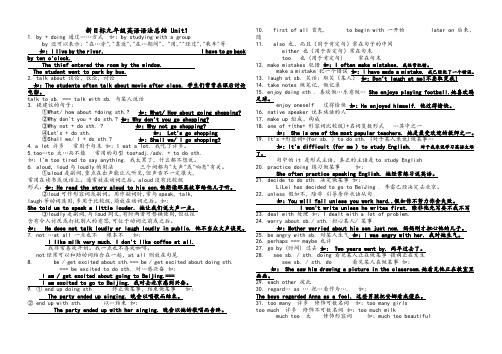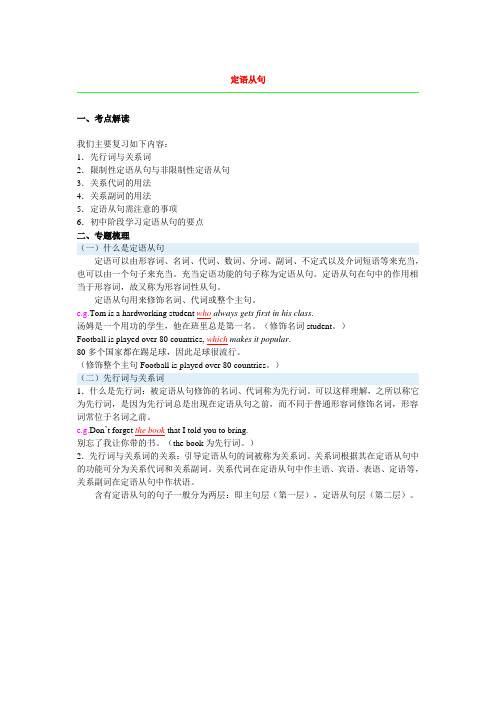2017年人教版新目标九年英语语法(定语从句)
- 格式:doc
- 大小:83.00 KB
- 文档页数:6

新目标九年级英语语法总结 Unit11. by + doing 通过……方式如:by studying with a groupby 还可以表示:"在…旁","靠近","在…期间"、"用,""经过","乘车"等如:I live by the river. I have to go back by ten o'clock.The thief entered the room by the window.The student went to park by bus.2. talk about 谈论,议论,讨论如:The students often talk about movie after class. 学生们常常在课后讨论电影。
talk to sb. === talk with sb. 与某人说话3. 提建议的句子:①What/ how about +doing sth.? 如:What/ How about going shopping?②Why don't you + do sth.? 如:Why don't you go shopping?③Why not + do sth. ? 如:Why not go shopping?④Let's + do sth. 如: Let's go shopping⑤Shall we/ I + do sth.? 如:Shall we/ I go shopping?4.a lot 许多常用于句末如:I eat a lot. 我吃了许多。
5.too…to 太…而不能常用的句型 too+adj./adv. + to do sth.如:I'm too tired to say anything. 我太累了,什么都不想说。


人教版新目标九年级英语教案Unit 9第九单元教学设计AUnit9 I like music that I can dance to(第1课时)一、教材分析定语从句是本单元的语法要点,是在1-8单元已经对该语法知识有所渗透的前提下安排的。
本节课话题是让学生体会音乐在生活中无处不在,体会不同类型音乐的特点,学会热爱生活;能用简单的定语从句形式表述自己的观点。
通过本节的学习,增强学生对复合句的理解,提高其对此句式的应用能力。
二、学生分析学生们已经有了初步的复合句的知识。
三、三维目标1、知识目标:掌握本单元基本词汇,学会恰当的使用引导词that ,who2、能力目标1)掌握功能句“What kind of music do you like ? I like music that I can dance to . I love singers who can write their ownmusic.”2)能够自如地谈论自己所喜欢的音乐和音乐家。
3、情感目标:通过学生谈论对音乐和音乐家的好恶,从而使学生学会欣赏音乐的美。
四、教学重点1)本节课的教学重点是学会并掌握先行词为物或者人时,引导词“that ,who ”的使用方法。
2)“prefer …to…”的用法3)掌握有关音乐的词汇和相关的词组,能够比较流利地描述自己喜欢的音乐,运用功能句“What kind of music do you like ? I like music that I can dance to . I love singers who can write their own music.”五、教学难点定语从句运用六、教学策略采用任务型语言教学,实施情境教学法、小组合作探究法、情感激励法。
七、教学准备自制多媒体课件(PowerPoint);录音机(A tape recorder)八、教学环节1、课堂导入⑴Warming up⑵Discuss: Do you like music? What kind ofmusic do you know?⑶There aremany kinds of music such as pop ,jazz, rock……. Let Sstalk about the kinds of music..(多媒体出示)⑷Let Ss read 1a. Explain the sentences:I prefermusic that has great lyrics=I like music that has great lyrics better.lyrics:the plural form is often used.Ask Ss topractice in pairs then make up a short passage using the four sentences on thescreen. 2、课堂讲授Explain attributive clauses.定语从句:在复合句中修饰名词或者代词的从句叫做定语从句。

定语从句一、考点解读我们主要复习如下内容:1.先行词与关系词2.限制性定语从句与非限制性定语从句3.关系代词的用法4.关系副词的用法5.定语从句需注意的事项6.初中阶段学习定语从句的要点二、专题梳理(一)什么是定语从句定语可以由形容词、名词、代词、数词、分词、副词、不定式以及介词短语等来充当,也可以由一个句子来充当。
充当定语功能的句子称为定语从句。
定语从句在句中的作用相当于形容词,故又称为形容词性从句。
定语从句用来修饰名词、代词或整个主句。
e.g.Tom is a hardworking student who always gets first in his class.汤姆是一个用功的学生,他在班里总是第一名。
(修饰名词student。
)Football is played over 80 countries, which makes it popular.80多个国家都在踢足球,因此足球很流行。
(修饰整个主句Football is played over 80 countries。
)(二)先行词与关系词1.什么是先行词:被定语从句修饰的名词、代词称为先行词。
可以这样理解,之所以称它为先行词,是因为先行词总是出现在定语从句之前,而不同于普通形容词修饰名词,形容词常位于名词之前。
e.g.Don’t forget the book that I told you to bring.别忘了我让你带的书。
(the book为先行词。
)2.先行词与关系词的关系:引导定语从句的词被称为关系词。
关系词根据其在定语从句中的功能可分为关系代词和关系副词。
关系代词在定语从句中作主语、宾语、表语、定语等,关系副词在定语从句中作状语。
含有定语从句的句子一般分为两层:即主句层(第一层),定语从句层(第二层)。
特别提示:①关系词一般紧跟在先行词之后引导定语从句。
定语从句总在被修饰的先行词后面。
②在定语从句中,关系代词起着代词和连词的作用,关系副词起着副词和连词的作用。


九年级英语Unit6【单元目标】Ⅰ.单词与短语单词prefer gentle remind heart latest feature display interest whatever miss suggest energy honest course suit expect taste actually mainly laboratory type cancer increase risk main shock短语1.prefer… to…比起…更喜欢…2.to be honest 老实说;说实在的3.remind of 提醒;使记起4.on display 展览;陈列5.be bad for 对…有害;有害于6.stay away from 与…保持距离7.be in agreement 意见一致8.dance to 随着…跳舞9.sing along with 伴随…唱歌10.be important to sb. 对某人重要11.be sure 确定;一定12.get together 聚集在一起13.cause cancer 致癌14.taste good 尝起来好Ⅱ.目标句型:---What / which kind of + n. + do / does sb like?---Sb like(s) / love(s) / prefer(s) / enjoy(s) +n. + that从句(表示一种限制)Ⅲ.语法定语从句(见最后一页)【重点词汇】1. prefer动词更喜欢宁愿a)prefer sth.更喜欢某事I prefer English. 我更喜欢英语。
b)prefer doing宁愿做某事To do 强调特定的或某次具体的动作He preferred reading at home on rainy days.c)即对某种行为的“偏爱”The boy preferred not to god)We prefer you to stay for dinnere)I prefer dogs to cats. 与猫相比我更喜欢狗。
人教版新目标初中英语语法大全初中英语语法学习提纲一、词类、句子成分和构词法:1、词类:英语词类分十种:名词、形容词、代词、数词、冠词、动词、副词、介词、连词、感叹词。
1、名词(n.):表示人、事物、地点或抽象概念的名称。
如:boy, morning, bag, ball, class,orange.2、代词(pron.):主要用来代替名词。
如:who, she, you, it .3、形容词(adj..):表示人或事物的性质或特征。
如:good, right, white, orange .4、数词(num.):表示数目或事物的顺序。
如:one, two, three, first, second, third, fourth.5、动词(v.):表示动作或状态。
如:am, is,are,have,see .6、副词(adv.):修饰动词、形容词或其他副词,说明时间、地点、程度等。
如:now, very, here, often, quietly,slowly.7、冠词(art..):用在名词前,帮助说明名词。
如:a, an, the.8、介词(prep.):表示它后面的名词或代词与其他句子成分的关系。
如in, on, from, above,behind.9、连词(conj.):用来连接词、短语或句子。
如and, but, before .10、感叹词(interj..)表示喜、怒、哀、乐等感情。
如:oh, well, hi, hello.2、句子成分:英语句子成分分为七种:主语、谓语、宾语、定语、状语、表语、宾语补足语。
1、主语是句子所要说的人或事物,回答是“谁”或者“什么”。
通常用名词或代词担任。
如:I’mMiss Green.(我是格林小姐)2、谓语动词说明主语的动作或状态,回答“做(什么)”。
主要由动词担任。
如:Jack cleans the roomevery day. (杰克每天打扫房间)3、表语在系动词之后,说明主语的身份或特征,回答是“什么”或者“怎么样”。
九年级英语全册单元语法知识点Unit 8:It must belong to Carla.第八单元的语法重点是:情态动词表推测。
情态动词表推测情态动词 must,may,might,could,may,can 表示推测含义与用法后面都接动词原形,都可以表示对现在情况的揣测和推断但他们含义有所不同。
① must 一定,肯定(100%可能性)② may,might,could 有可能,也许(20%、80%可能性)③ can't 不可能,不会(可能性几乎为零)如:The dictionary must be mine.It has my name on it.The hair band can't be Bob's.After all,he is boy!【直击中考】1.【吉林长春】20.-Are the glasses Tim's?-No,they _______ be his.He doesn't wear glasses.A.mustB.canC.mustn'tD.can't2.【江苏宿迁】5.-Excuse me,is this the way to No.10 Middle School?-Oh,sory.I'm not sure.But it ______ be.A.mustB.shouldC.needD.mayUnit 9:I like music that I can dance to.第九单元的语法重点是:定语从句。
定语从句★定语从句:在复合句中,修饰某一名词或代词的从句叫做定语从句。
定语从句可以分为限制性定语从句和非限制性定语从句。
本单元主要学习由 who、that、which 引导的限制性定语从句。
★先行词:被定语从句所修饰的名词或代词称为先行词。
★关系代词:引导定语从句的关联词称为关系代词。
关系代词在定语从句中有三个作用:(1)引导定语从句;(2)代替先行词;(3)在定语从句中充当一个成分。
人教版九年级英语(全册)重点语法知识点复习梳理人教版九年级英语重点语法知识点复习梳理一.介词by的用法(Unit-1重点语法)1.意为“在……旁”,“靠近”。
Some are singing and dancing under a big tree. Some are drawing by the lake.有的在大树下唱歌跳舞。
有的在湖边画画儿。
2.意为“不迟于”,“到……时为止”。
Your son will be all right by supper time.你的儿子在晚饭前会好的。
How many English songs had you learned by the end of last term?到上个学期末你们已经学了多少首英语歌曲?3.表示方法、手段,可译作“靠”、“用”、“凭借”、“通过”、“乘坐”等。
The monkey was hanging from the tree by his tail and laughing.猴子用尾巴吊在树上哈哈大笑。
The boy’s father was so thankful that he taug ht Edison how to send messages byrailway telegraph.孩子的父亲是那末的感谢,因而他教爱迪生怎样经由过程铁路电报来转达息。
4.透露表现“逐个”,“逐批”的意思。
One by one they went past the table in the dark.他们一个一个得在黑暗中颠末这张桌子。
5.表示“根据”,“按照”的意思。
What time is it by your watch?你的表几点了?6.和take , hold等动词连用,说明接触身体的某一部分。
I took him by the hand.我拉住了他的手。
7.用于被动句中,表示行为主体,常译作“被”、“由”等。
English is spoken by many people.英语被许多人说。
人教版新目标初中英语语法大全初中英语语法学习提纲一、词类、句子成分和构词法:1、词类:英语词类分十种:名词、形容词、代词、数词、冠词、动词、副词、介词、连词、感叹词。
1、名词(n.):表示人、事物、地点或抽象概念的名称。
如:boy, morning, bag, ball, class,orange.2、代词(pron.):主要用来代替名词。
如:who, she, you, it .3、形容词(adj..):表示人或事物的性质或特征。
如:good, right, white, orange .4、数词(num.):表示数目或事物的顺序。
如:one, two, three, first, second, third, fourth.5、动词(v.):表示动作或状态。
如:am, is,are,have,see .6、副词(adv.):修饰动词、形容词或其他副词,说明时间、地点、程度等。
如:now, very, here, often, quietly,slowly.7、冠词(art..):用在名词前,帮助说明名词。
如:a, an, the.8、介词(prep.):表示它后面的名词或代词与其他句子成分的关系。
如in, on, from, above,behind.9、连词(conj.):用来连接词、短语或句子。
如and, but, before .10、感叹词(interj..)表示喜、怒、哀、乐等感情。
如:oh, well, hi, hello.2、句子成分:英语句子成分分为七种:主语、谓语、宾语、定语、状语、表语、宾语补足语。
1、主语是句子所要说的人或事物,回答是“谁”或者“什么”。
通常用名词或代词担任。
如:I‘mMiss Green.(我是格林小姐)2、谓语动词说明主语的动作或状态,回答“做(什么)”。
主要由动词担任。
如:Jack cleans the roomevery day. (杰克每天打扫房间)3、表语在系动词之后,说明主语的身份或特征,回答是“什么”或者“怎么样”。
初三英语语法:定语从句定语从句(Attributive Clauses)通常皆放在它所修饰的名、代词之后,这种名、代词就叫做先行词。
引导定语从句的关联词为关系代词和关系副词。
1.关系代词引导的定语从句在下面几种情况下必须用关系代词that引导定语从句:(1) 先行词是不定代词all ,few, little, everything ,nothing anything, none等。
如:Is there anything that you want to buy in the shop?你在商店里有什么东西要买吗?(2) 先行词被序数词或形容词最高级所修饰,或本身是序数词、基数词、形容词最高级。
如:This is the best movie I’ve ever seen.这是我看到过的最好的一部电影。
(3) 先行词被all, any ,every ,each, few, little, no ,some等修饰时。
如:I have read all the books(that )you gave me.我读了你给我的所有的书。
(4) 先行词被the only , the every ,the same, the last 修饰时。
如:He is the only person that I want to talk to .他就是我要谈话的那个人。
(5) 当并列的两个先行词分别表示人和物时。
如:They are talking about thins and persons that they remembered. 他们在谈论他们所能回忆起来的人和事。
(6) 为避免重复,在以who或which开头的特殊疑问句中。
如:Who is the girl that is crying ?正在哭泣的那个女孩是谁?Which of the books that borrowed from the library is yours.从图书馆借的哪一本书是你的?(7) 用作关系代词,修饰表示时间的名词如day, time , moment 代替when 。
如:It happened on the day that/when he was born这事碰巧发生在他出生的那天。
(8) 如果有两个定语从句,其中一个关系词已用which则另一个用that 。
如:The country built up a factory which produced things that have never been seen before.这个国家建立了一个工厂,生产以前未曾见到过的东西。
(9) 主句以there be开头。
如:This is a seat in the corner that is still free.那个角落还有个座位空着。
2. 限制性定语从句(1) who引导的限制性定语从句关系代词who用于指人,通常在句中作主语。
在非正式文体中,who可以代替whom在句中作动词宾语和介词宾语,而且常常省略。
在作介词宾语时,不能位于介词之后。
如:A doctor is a person who looks after people’s health. 医生是关照人们健康的人。
Nobody who understands the subject would say such a thing.懂这一行的人是不会说这样的话的。
The man who I saw is called Smith. 我见到的那个人名叫史密斯。
There’s no one works harder than you. 没有比你更用功的人了。
(no one后省去了用作主语的who)(2) whom引导的限制性定语从句The gentleman whom she encountered addressed her with courtesy.她相遇的那位先生很有礼貌地和她讲话。
I have just met a lady (whom) I saw last week.我刚遇到一位我上个星期见过的贵妇人。
关系代词whom用于指人,是who的宾格形式,在从句中作动词宾语或介词宾语,常常省略。
whom作介词宾语时,介词可位于whom之前或句末,在非正式文体中常位于句末;紧接介词的whom不能省略。
He wanted to find someone with whom he could discuss books and music.他想找个能共同研讨书和音乐的人。
This is the teacher (whom) we have talked about. 这就是我们谈论过的那个老师。
(3) whose引导的限制性定语从句whose是关系代词who的所有格形式,在从句中作定语。
whose通常指人,也可指动物或无生命的事物:An electromagnet is a device whose magnetism is produced by an electric magnet.电磁铁是一种由充电的磁铁产生磁力的装置。
You're the only one whose advice he might listen to. 只有你的话他可能会听。
I'd like a room whose window looks out over the sea.我想要一个窗户面临大海的房间。
(4) which引导的限制性定语从句She was not on the train which arrived just now. 她不在刚才到达的那列火车上。
关系代词which在从句中作主语或介词宾语,作宾语时常常省略。
which作介词宾语时,介词可位于是which之前或句末,在非正式文体中常位于句末;紧接介词的which不能省略。
which主要用于指无生命的事物,除此之外,还可指婴儿、动物、以及某些表示单数意义的集体名词。
(5) 关系代词that引导的限制性定语从句关系代词that既可指人,又可指物。
它在从句中可以作主语、动词宾语、介词宾语和表语。
that作动词宾语或介词宾语时常常省略。
在作介词宾语时,介词须位于句末,而不能位于that之前。
Water that is impure often causes serious illness. 水不洁常会引起重病。
Fanny,bring the water and put it down in the middle of the room,lazy creature that you are. 范妮,拿水来,放在屋子当中,你这懒鬼。
(6) when等引导的限制性定语从句关系副词when指代和修饰主句中表示时间的先行词,在从句中作时间状语,可以省略。
在语义上,when相当于“介词+which”。
如:July and August are the months when the weather is hot.七八月是天气很热的月份。
Every hour since I came has been most enjoyable.我来之后的每一个小时都是非常好玩的。
On the day before we left home there came a snow storm.在我们离家的前一天,下了一场暴风雪。
(7) where引导的限制性定语从句关系副词where指代和修饰主句中表示地点的先行词,在从句中作地点状语,当先行词为place时,where可以省略。
在语义上,where相当于“介词+which”:The knee is the joint where(=at which)the thigh bone meets the large bone of the lower leg.膝盖是大腿骨和小腿大骨相连处的关节。
She’s going hom e where she can rest. 她要回家了,在家里她可以休息。
A stone marks the spot where the treaty was signed.有一块石头标着那个签订条约的地方。
(8) why引导的限制性定语从句关系副词why的先行词只有reason,在从句中作原因状语,可以省略:The reason why he left is not convincing. 他离开的理由无法令人信服。
There was no definite reason why she should do so. 她这样做并没有什么一定的理由。
(9) 关系代词as引导的限制性定语从句关系代词as既可指人,又可指物,在从句中作主语、宾语、状语或表语。
其具体用法如下:①as与the same连用:This is the same computer as I have bought. 这台计算机和我买的那台一样。
(as作宾语)I’ll do the experiment the same way as he does.我将采用和他同样的方法做这个实验。
( as作方式状语)he studies in the same college as I do.他和我在同一所大学学习。
( as作地点状语)②as与such连用:They returned with coffee,wine,and such provisions as were needed.他们带着咖啡、葡萄酒以及所需的给养回来了。
(主语)Here are such questions as are of ten asked by the college students.这是些大学生们常常问的那类问题。
(as作主语)I have never seen such kind of girl as she is. 我从未见过像她这样的女孩。
(as 作表语)H e didn’t believe such reason as she did so.他不相信她那样做的理由。
(as 作原因状语)③as与as连用:There is as good fish in the sea as ever came out of it. 海里有的是鱼(天涯何处无芳草)。
(主语)She tried to make as few mistakes as she could avoid. 她尽可能地避免犯错误。
(动词宾语)④as与so连用:He can tell so interesting a story as moves us to tears. 他能讲把我们感动得流泪的故事。
(主语)Here is so big a stone as no one can lift. 这是一块没人能搬得动的大石头。